Abstract
Nowadays, stricter control and rigorous landfill standards are being promoted in industries that produce liquid discharges into the environment. The development of innovative and sustainable technologies to remove lead from water is of great importance in all aspects, with safe recycling practices, especially with high lead concentrations, such as in mining activities. The experiment was conducted at a reverse osmosis (RO) pilot plant, operated at low impact pressures and designed to optimize energy savings without compromising separation efficiency. By reducing energy consumption, the process not only lowers operational costs but also minimizes the environmental impact associated with high energy consumption. The results show that RO operated at low pressures successfully removed 99.75% of lead at a pressure of 10 bar and a flux of 67.44 L/m2·h, demonstrating a practical and sustainable solution for lead removal at pressures of 5, 7.5, and 10 bar, which are considered low pressures since they are below 1.0 MPa. In addition to its high removal efficiency, the process offers significant advantages in terms of energy efficiency and a reduced carbon footprint. Enhancing the efficiency of this technology is crucial, not only to decrease operational costs but also to reduce environmental impact.
1. Introduction
The importance of water as a vital resource is undeniable. Population growth and anthropogenic activities contribute to water pollution. This increases the need to find economical and safe methods for its treatment to give it some other use or for its return to the environment without generating negative impacts on local inhabitants [1]. It is also essential to reduce energy consumption and enhance sustainability in pollutant removal technologies, as this contributes to the achievement of several Sustainable Development Goals (SDGs). Particularly, Goal 6: Clean Water and Sanitation, specifically Target 6.3, which aims to improve water quality by reducing pollution, eliminating dumping, and minimizing the release of hazardous chemicals and materials, as well as halving the proportion of untreated wastewater and substantially increasing recycling and safe reuse globally. It also supports Goal 7: Affordable and Clean Energy, particularly Target 7.3, which seeks to double the global rate of improvement in energy efficiency. Additionally, it aligns with Goal 12: Responsible Consumption and Production, especially Target 12.4, which focuses on the environmentally sound management of chemicals and all wastes throughout their life cycle, according to agreed international frameworks, to significantly reduce their release into the air, water, and soil, thereby minimizing their adverse effects on human health and the environment [2].
Among the most prevalent contaminants in water are coliform bacteria, organic matter, suspended solids, fertilizers, pesticides, and, significantly, heavy metals [3]. Mining can significantly impact water quality and aquatic ecosystems through several mechanisms, with acid mine drainage (AMD) being one of the most well-known and harmful. This acid leaches heavy metals from surrounding rocks, creating a toxic, acidic runoff that can enter nearby rivers, lakes, and groundwater. AMD severely lowers pH levels in water, harming aquatic life and contaminating drinking water sources [4]. Lead in water has led to worrying situations worldwide, affecting public health. In 2014, the city of Flint, Michigan, experienced a crisis when changing the source of its water supply, and the Flint River water began to corrode lead pipes, releasing high levels of the mineral in water and affecting the health of thousands of residents, especially children [5]. Lead poisoning is a major global health concern, particularly affecting children. Lead exposure has resulted in the poisoning of one-third of children globally, with the primary sources being the use of lead pipes and activities related to mining [6]. According to a 2020 study published by the United Nations Children’s Fund (UNICEF), an estimated 800 million children worldwide have blood lead levels at or above five micrograms per deciliter (µg/dL). This report was the first to comprehensively assess the global scale of childhood lead exposure [7]. In Table 1, data on lead global production and usage are shown [8].

Table 1.
World refined lead supply and usage 2020–2025 (×103 tonnes).
Lead represents one of the main minerals produced in Bolivia, giving rise to considerable lead emissions into the environmental matrices in areas close to mining operations, especially near roads, fruit orchards, and industrial zones [9,10]. This phenomenon affects the flora, fauna, and inhabitants who reside near production areas or lead deposits [11]. Lead can be absorbed into soil or contaminate water, affecting vegetative species and other living beings [12]. Lead bioaccumulation in the soil, water, and air produces an increase in environmental pollution rates [13]. There is an alarming situation regarding lead in different bodies of water, reaching a wide presence like other heavy metals [14]. The production volumes of lead extracted in Bolivia since 2010 are shown in Table 2 [15].

Table 2.
Lead production in Bolivia in metric tons.
The exploitation of lead in San Cristóbal mine (one of the largest mine facilities in Bolivia) could last up to 147 years [16]. According to the International Lead and Zinc Study Group (ILZSG), global lead production continues to remain elevated, highlighting the ongoing demand for and extraction of lead worldwide [8]. In Bolivia, this trend is likely to continue, with lead mining operations potentially expanding, which in turn could lead to further contamination of local water sources. This persistent production and extraction of lead contribute to both global pollution and localized environmental challenges, particularly in water quality, exacerbating the risk of lead contamination for surrounding communities.
Given the problems caused by heavy metals, various technologies have been developed for their elimination or inactivation. Some removal methods are membrane filtration, ion exchange, adsorption by activated carbon, and coagulation–flocculation, among others [17].
Research on membrane filtration technology is constantly growing and has yielded positive results [18,19,20]. The study by Vera et al. involved using osmosis membranes to remove Pb and Cd from mining wastewater. The study achieved an osmosis rejection of 98.77% for Pb and 98.30% for Cd [19]. Another successful experience was recorded in the removal of metal ions such as lead, achieving removal percentages of 98.9% and 98.7% using RO and nanofiltration (NF), respectively [19]. Reverse osmosis membranes have demonstrated high efficiency in removing not only lead but also other toxic metals, reinforcing their potential as a versatile and reliable water treatment technology. In the case of arsenic, removal rates ranging from 90% to 99% have been achieved, while tests involving hexavalent chromium have shown removal efficiencies as high as 99.9% [21]. In addition, Villena Martines et al. reached a rejection rate greater than 99% using heavy metals such as arsenic and lead [22]. On the other hand, low-pressure reverse osmosis studies were addressed, showing effective results on municipal wastewater treatment [23]. The use of low pressures in reverse osmosis obtained percentages of rejection greater than 90% in anionic pollutants from wastewater [24], showing that low pressures confer a reduction in environmental impact while minimizing energy consumption [25]. The objective of this research was to optimize the working pressure range for RO, using a pilot plant to remove lead and seeking to maintain high metal removal with more sustainable energy costs. With the demand for the removal of heavy metals, such as lead from water, the need arises to obtain high efficiencies with existing technologies and at the same time a low energy cost, aiming at sustainability.
2. Materials and Methods
To ensure a reliable and comprehensive assessment of lead removal through reverse osmosis, a full factorial experimental design was developed using Minitab 19 software, followed by preliminary tests in the pilot plant, synthetic water preparation, systematic experimentation under varying conditions, and statistical evaluation of the results. The methodological sequence used to develop this research is detailed in Figure 1.
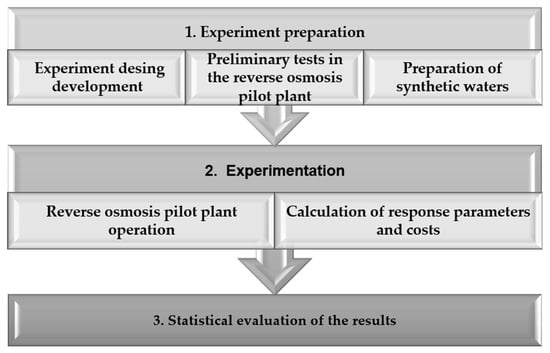
Figure 1.
Methodological scheme.
2.1. Experiment Preparation
2.1.1. Experiment Design Development
A general full factorial design was used in planning the experiments. This experimental design was generated to obtain statistically robust results that cover the variables studied. The statistical program used, MiniTab 19, developed by LLC, State College, PA, USA [26], is a user-friendly interface with powerful statistical tools and facilitates data manipulation in this type of design. In Figure 2, the interface for creating factorial designs within the program is shown.

Figure 2.
Factorial design creation interface in Minitab 19. Minitab 19 interface allows you to enter an independent number of factors (left window), as well as an independent number of replicates and levels for each factor (right window).
The experimental design incorporated two input variables: pressure and average inlet flow. Response variables included analytical mean flux, conductivity rejection, and lead rejection rate. The conductivity rejection acted as a guiding parameter that is similar to the percentage of conductivity removal of lead ions from a contaminated solution [27]. On the other hand, flux is considered a crucial parameter in understanding the production of treated water [28,29,30]. The lead rejection rate indicates the amount of lead removed from the water with respect to an initial amount [31]. These indicators allowed the evaluation of removal technology, seeking sustainable conditions, since, according to previous experiences, less energy is consumed with low pressures of less than 1 MPa (10 bar) [30]. Industrial conditions of pressure commonly range from 10 bar to 70 bar, which means that the present study considers pressures under these parameters [32].
2.1.2. Initial Tests in the RO Pilot Plant
Preliminary tests were carried out prior to experimentation with the RO pilot plant. Thanks to this, it was possible to determine the initial conditions provided by the membrane without coming into contact with the metal under study. These tests consisted of executing the established runs with the parameters used according to another study carried out with the same membrane, that is, at a pressure of 10 bar and a frequency of 20 Hz. The plant was operated under these conditions for a period of 20 min, during which the stability of the permeate and concentrate flow rate data was monitored. Temperature correction is necessary to consider the dependence of permeability on temperature [22], and results are not affected by the increase in temperature that occurs due to the heating of the water pump within a closed system in which water recirculates. This correction involves the Arrhenius equation:
where
ln(Ap) = ln(A) − Ea/R · 1/T
- Ap = apparent permeability [L/(m2·h·bar)];
- A = pre-exponential factor;
- Ea = activation energy;
- R = ideal gas constant;
- T = temperature [K].
Flux is the permeate flow rate, Qp, obtained at the membrane outlet, divided by the membrane surface [33]:
where
J = Qp/S
- J = flux [L/(m2·h)];
- Qp = permeate flow rate [L/h];
- S = surface area [m2].
Permeability, Ap, is given by Equation (3) [34,35]:
where
Ap = J/P
- Ap = Apparent permeability [L/(m2·h·bar)]
- J = Flux [L/(m2·h)]
- P = Pressure [bar]
Subtracting the final state, 2, from the initial state, 1, using Equation (1) and substituting Equations (2) and (3) into it, the following is obtained:
J2/S2 = J1/S1 · e^(−Ea/R · (1/T2 − 1/T1))
By having the same membrane area, this data is eliminated, and the term Ea/R is a constant, which will be called K. Finally, the equation is
where
J2 = J1 · e^(−K · (1/(273 + t) − (1/293))
- J2 = flux corrected with respect to temperature [L/(m2·h)];
- J1 = flux without correction [L/(m2·h)];
- K = Ea/R = 3573.2 = correlation constant with respect to different temperatures, obtained for the plant’s working conditions.
- t = Temperature [°C]
2.1.3. Preparation of Synthetic Waters
A total of 40 L (Vd) of lead solution with a concentration of 1 ppm or mg/L(Cd) was prepared. The synthetic water was prepared by adding a lead standard solution from InorganicTM Ventures with a concentration of 1000 ug/mL (Cs) in distilled water. The lead standard solution is composed of a 0.5% v/v in a medium of HNO3.
This procedure was carried out to establish an initial concentration that exceeded by 20 times the limits allowed by various organizations, as established by Bolivian regulations (0.05 mg/L) from the Regulation on Water Pollution—RMCH [36]. This lead limit is aligned to the limit established by the European Union (EU) [37]. The purpose of this choice was to evaluate the effectiveness of lead removal until reaching the permissible limits.
A volume of 40 mL of the standard solution was used to prepare 40 L of synthetic water with a final lead concentration of 1 mg/L (1 ppm). Serial dilutions were performed to calibrate the multiparameter equipment and observe the behavior of conductivity and pH at different concentrations. These parameters give a method to measure the quantity of lead ions present in the water. For the measurement, the Hach brand multiparameter model HQ40d was used.
2.2. Experimentation
The experimentation consisted of varying the parameters of pressure, average inlet flow and average analytical flux, measured through sensors. The opening of the valves and frequency were varied according to the limits to achieve each of the desired experimental scenarios.
2.2.1. Reverse Osmosis Pilot Plant Operation
The pilot plant operation was carried out with 40 L of synthetic water with lead solution at 1 mg/L. Figure 3 presents the scheme of the RO pilot plant.
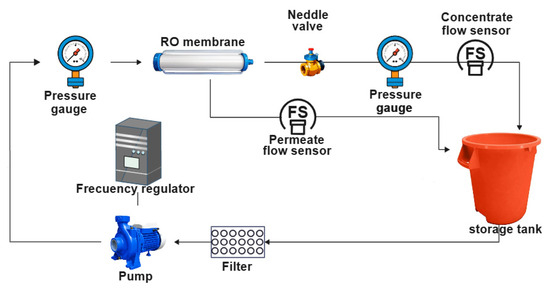
Figure 3.
Scheme of components of the reverse osmosis pilot plant.
The pilot plant, based on a cross-flow system, is shown in Figure 3. It has a Keensen-brand aromatic polyamide semipermeable membrane, Changsha, China, model ULP-2540, and Wave Cyber 2540-300-1 casing, Shangái, China, presenting a contact area of 2.5 m2. The movement of water within the plant is driven by a multistage centrifugal/electric LEO pump, model 2ACM150H, Wenling, Zhejiang, China with a power of 2HP and 40 bar of pressure, with its filter regulated through a pressure valve. In addition, it has flow sensors at the entrance and exit of the membrane in [L/min], an integrated circuit for turning the plant on and off, and a frequency regulator on the control panel. Additional characteristics are shown in Table 3.

Table 3.
Characteristics of membrane ULP-2540 [38].
The pressure and flow levels were adjusted according to the operating parameters of the reverse osmosis pilot plant and the maximum frequency levels in Bolivia (50 Hz) [39]. Pressure levels were categorized as low (5 bar), medium (7.5 bar), and high (10 bar), taking into account that these pressures are considered low pressures when it is possible to reduce energy consumption [22,30]. Regarding the flow parameters, an average inlet flow was established and divided into two levels: low (290–320 L/min) and high (350–380 L/min), considering that 40 L is the minimum capacity of the plant.
2.2.2. Calculation of Response Parameters
The percentage of conductivity rejection and lead rejection rate were calculated. The conductivity rejection (R%) of the metal ion and lead rejection rate (C%) are determined by replacing the values into Equation (6) [27]:
where
V% = (Vi − Vf)/Vi · 100%
- Vi = initial value;
- Vf = final value.
With a simple mass balance of the system, Equation (7) is obtained in terms of concentrate (C1) and permeate (P1).
C1 = F1 − P1
Flow data was taken every 6 s, through the sensors at the inlet (F1) and outlet of the plant module (P1 + C1). On the other hand, a sample of the feed was taken at the beginning of the tests and permeated at both 10 min and 20 min to take the in situ parameters of conductivity and pH, using a Hach-brand multiparameter, model HQ40d, while lead concentrations were measured through a Perkin Elmer-brand atomic absorption spectrophotometer, model AAnalyst 200, which allows a single measurement of the UV lamp.
2.3. Statistical Evaluation for the Results
The data was entered into Minitab 19 for statistical analysis. As a result, a parametric ANOVA (Analysis of Variance) table was generated to determine the significance of the control variables, pressure and flow rate, on the response variables, analytical flux and conductivity rejection. The ANOVA obtained was normally distributed thanks to the stability of the process and the results measured. In addition to the ANOVA output, Minitab provided main effects plots and interaction graphs, which allowed for a deeper understanding of how each factor independently and jointly influenced the system’s performance. These visual tools made it possible to observe the behavior of the response variables across different levels of pressure and flow, revealing not only the individual impact of each parameter but also how their interaction affects the overall efficiency of lead removal. This analysis is essential for identifying optimal operational conditions and supports the development of more energy efficient and sustainable treatment strategies.
In Bolivia, there are companies that offer energy consumption prices depending on the quantity of kWh consumed. For this study, the prices given by the DELAPAZ company refer to 0.969 BOB (0.14 USD) per kWh consumed [40].
2.4. Calculation of Costs
To estimate the energy cost associated with the operation of the reverse osmosis pilot plant, the total electrical consumption during the experimental runs was considered. Calculations were taken into account along with the operating conditions and electricity tariff.
The energy consumed by the pilot plant is calculated using a general formula, shown in Equation (8):
where
E = Qp·P·t/η
- E = energy consumed [kWh];
- Qp = permeate flow rate [m3/h];
- P = operating pressure [bar];
- T = operating time [s];
- η = pump efficiency.
This analysis allows for quantifying energy consumed per volume of treated water and evaluating the economic feasibility of the process [41].
3. Results
3.1. Initial Test Results
After operating the membrane system for 20 min (1200 s) at a pressure of 10 bar and a frequency of 20 Hz, the permeate flow rate was obtained. The distribution of the data is presented in Figure 4.
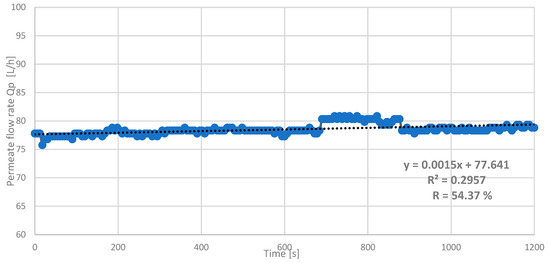
Figure 4.
Membrane permeate test.
As seen in Figure 4, this provides an indicator to take into account membrane fouling, playing the role of a control mechanism to clean the membrane after its use. So, it would be used after prolonged use of the pilot plant, meanwhile it did not show significant variation.
A temperature correction was carried out during the preliminary tests. This correction took into account the minimum temperature recorded in the laboratory, from 15.5 °C to 26.1 °C, that was reached during the run.
Regarding temperature correction, once Equations (1)–(3) were applied to the recorded temperatures, pressures, and flux, the results were graphed with a linear trend. The obtained data is presented in Figure 5.
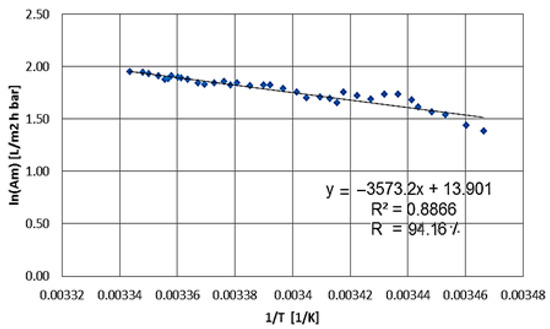
Figure 5.
Temperature correction. Shows a descending linear trend line, where the constant −Ea/R is shown to have a value of −3573.2, the ln(A) is 13.901, and a multiple correlation coefficient R = 94.16% is obtained.
3.2. Experimentation Results
The following section presents an analysis of the experimental data obtained from the reverse osmosis pilot plant trials, designed to assess the efficiency of lead removal under different operational scenarios. Key response variables such as flux, conductivity rejection, and lead removal rate were examined to understand the influence of pressure and flow conditions. The results obtained for removing lead by filtration with membrane RO are presented in Table 4.

Table 4.
Summary table of lead removal experimentation by reverse osmosis.
Table 4 shows that the conductivity rejection and lead rejection rates are consistently high in all tests, exceeding 99% and 92.98%, respectively. Conductivity serves as a secondary measurement parameter to support removal percentages due to the conductivity of the solution including not only lead ions, but also nitrate ions.
3.3. Statistical Evaluation of the Results
Once the results were entered into the Minitab 19 statistical program, an ANOVA table was extracted for the proposed experimental design, which is presented in Table 5.

Table 5.
ANOVA table for RO factors.
The data obtained from Table 5 indicates that pressure has a significant impact on analytical mean flux, since its p-value is less than 0.05. On the other hand, the variation in flow does not present a significant effect, since its p-value is greater than 0.05. Furthermore, according to the analysis, neither pressure nor flow rate shows significance in the rejection of conductivity.
The effects of analytical mean flux concerning pressure and flow are presented in Figure 6.
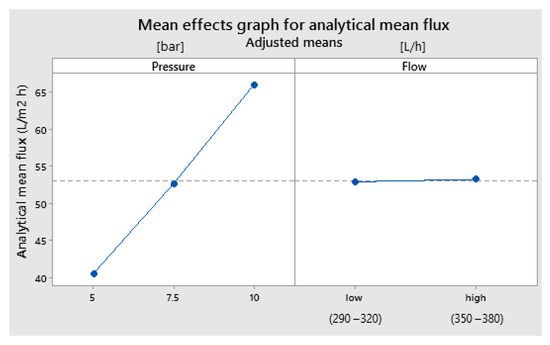
Figure 6.
Main effects for analytical mean flux.
As seen in Figure 6, the variation in average analytical flux depending on pressure is notable, while flow does not generate much apparent change in the flux.
In Figure 7, the variation in pressure and flow does not generate a wide range of changes in mean conductivity rejection. Despite this, in all cases, a rejection rate exceeding 90% was recorded.
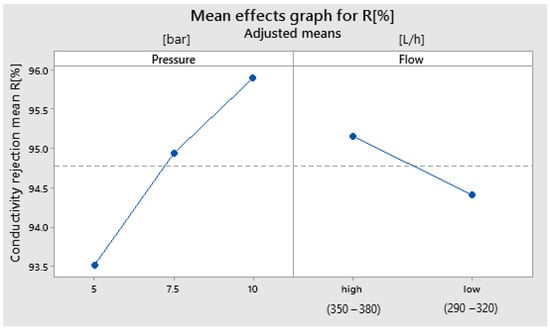
Figure 7.
Main effects for conductivity rejection in reverse osmosis.
According to Figure 8, (a) an increase in average analytical mean flux is observed as both pressure and flow rate increase for both flow levels. This results in greater flux under high-pressure and -flow conditions; (b) at lower levels of flow and pressure, a slight increase in conductivity rejection is achieved. However, this trend is reversed by increasing both flow and pressure, thus reaching maximum rejection in the latter scenario.
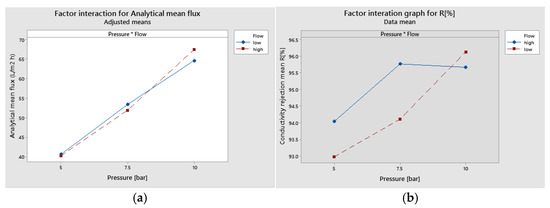
Figure 8.
Interaction of factors for analytical mean flux and conductivity rejection. (a) Analytical mean flux response. (b) Conductivity rejection means that at lower levels of flow and pressure, a slight increase in conductivity rejection is achieved. However, this trend is reversed by increasing both the flow and pressure, thus reaching the maximum rejection in the latter scenario.
During the testing of the reverse osmosis pilot system, both advantages and disadvantages were observed. While the cost is a drawback, it can be reduced by regulating the pressure, which lowers the environmental impact, reduces energy consumption, and enhances sustainability. Conducting this experiment with RO pilot plants is essential to replicate real operational conditions, allowing accurate and sustainable data on process behavior and scaling.
3.4. Results of Calculation of Costs
The present study measured an efficiency of 0.8 due to the pump of the pilot plant being a new machine without any problems during its operation [41]. Each run’s duration was 20 min, which is 0.333 h. The results obtained are shown in Table 6.

Table 6.
Energy and costs consumed during the study.
Table 6 presents the results obtained after substituting permeate flow, pressure, and time data into Equation (8). Once the energy results were obtained, we used the electricity tariff of the DELAPAZ company from Bolivia to calculate the costs of operation for each essay.
4. Discussions
4.1. Discussions of Results
Membrane filtration technology, particularly in the context of RO systems, offers several significant advantages. These systems are compact, requiring minimal operating space, and are known for their ease of operation and quick processing capabilities [18,42]. They can also be integrated into both parallel and series configurations to enhance performance, providing flexibility in various applications. Additionally, membrane filtration systems boast an impressive lifespan of 15 to 20 years, with stable efficiency over extended periods. When operated under controlled conditions, these systems can also deliver notable energy savings [23,30]. However, this technology does come with some challenges. The initial cost of equipment and installation is relatively high, though the prices of key components have been decreasing [25,43]. Furthermore, certain compounds may accumulate on the membrane surface, leading to fouling and reduced performance [23,30]. To mitigate this, pretreatment of the feedwater or ensuring the water quality is sufficient is essential to prevent premature clogging and damage to the membrane [17,23]. Notably, the lack of an energy recovery device in some original designs limits the potential for optimizing energy usage [42].
On the one hand, this study shows that energy savings can be achieved even when operating at the maximum pressure selected for the experiment (10 bar). Therefore, operating costs can be reduced, along the same lines as indicated in [30]. Furthermore, high Pb removal rates were achieved under unconventional pressure conditions below 10 bar, as was also seen in the study by Villena et al., where similar removal percentages were achieved [22]. This aspect makes the RO process operated under low-pressure conditions while maintaining separation efficiency a more sustainable and environmentally friendly option. On the other hand, the solute transport permeability adhered to an Arrhenius type correlation, as pointed out in [19,44]. This made it possible to examine how temperature influences the performance of the reverse osmosis process. According to [43], there is a possibility of decreasing the total energy consumption in a range of 47% to 53.8% when the variables are controlled, compared to the calculation for the original design that lacks an energy recovery device.
As mentioned in [45], conducting experiments with reverse osmosis pilot plants becomes essential to replicate operating conditions that resemble reality. This approach is crucial to obtain accurate and sustainable information to scale the process behavior. In general, the main disadvantage of RO is the cost of both implementation and operation. Still, this work presents preliminary studies demonstrating that it is possible to remove lead from synthetic waters operating under unconventional pressure conditions, which translates into optimizing the RO operating cost. This is reinforced by the study by Leon et al., where it was presented that the optimization of RO operation can reduce the cost per cubic meter of produced water and thus reduce the carbon footprint of the process [45].
4.2. Energetic and Circular Economy Reflections
The present study shows high rejection rates for Pb obtained at low operating pressures, which means energy savings. The above is aligned with a study that used RO membranes at different sizes, which showed an improvement in the energy efficiency of the system even at low pressures, saving operation costs and reducing the carbon and ecological footprints in the Canary Islands [44]. Energy savings shown in this study are a good reference based on the comparison with other conventional treatments of surface water. In general, RO systems consume 0.2–0.4 kWh, and the average flux produced is about 25 L/m2·h [25]. On the other hand, the present study ranged from 0.13963 to 0.19163 kWh (Table 6). Concerning average flux, the study turns into a competitive stage, producing from 40.61 to 67.44 L/m2·h.
This is an important step for developing countries such as Bolivia because it includes economic savings in the water treatment. At the same time, the use of less energy implies that the process is eco-efficient and sustainable, which coincides with the research [22,43]. The present work as a preliminary study opens the doors to future investigations where greater scalability can be applied at the industrial level and with real water conditions.
In countries like Bolivia, where mining is one of the main economic activities, it is necessary that the metals removed during the water purification process return to the productive chain. For this purpose, the recovery of Pb through other methods of extraction, such as chemical precipitation or electrodialysis, will be a good opportunity to take advantage of trace amounts of Pb trapped in the reverse osmosis process [46]. However, a deeper investigation into metal recovery methods within the mining sector is necessary to accurately evaluate the actual recovery rates achieved and to identify the operational and technical limitations that may hinder the efficiency and sustainability of these processes.
5. Conclusions
The negative impact of lead on the environment and public health is of great concern. Like other heavy metals, lead is mined in large quantities and released into the environment, often without undergoing any treatment process. Illegal mining emerges as a significant source of lead contamination of water resources. There are active technologies that achieve high removal rates, close to 100%, but high operating costs limit their application. This research offers a vision of the Bolivian context and the danger that the world faces due to the presence of lead in water.
Experimentation through RO membrane filtration has yielded promising results. The conductivity rejection percentages in membrane tests ranged between 92.98% and 96.13%. Regarding the lead rejection rate concerning the lead concentration, significant values were obtained, all around 100%, with a maximum rejection rate of lead of 99.75%.
The use of technology such as membrane filtration contemplates various potential applications in different industrial sectors. Significant advances and improvements in this technology allow for the regulation of more environmentally friendly working conditions without compromising removal efficiency. During experimentation, it was highlighted that controlling conditions on a pilot scale contributes to reductions in operational failures and continuous monitoring of removal performance. The process reduced energy consumption by 30% compared to conventional operation conditions. At the same time, the average flux produced almost tripled with respect to that when normal conditions for RO are used.
RO emerges as a quick solution to address the contamination of water bodies, which demands immediate action. RO is a great precedent to begin decontaminating mining liabilities in different regions of the world. Although this article focuses on lead removal, the use of membranes can cover a large number of contaminants present in bodies of water. The results obtained are a contribution to the SGDs, specifically Goal 6 Target 6.3, because the present study address future research to minimize and remove hazardous chemicals such as lead in untreated wastewater from mining, Goal 7 Target 7.3, because reducing energy costs involves increasing energy efficiency, and Goal 12 Target 12.4, on the management of chemicals—in this case, lead—to significantly reduce their release into water and minimize their negative impacts on human health and the environment.
Although our study with a single heavy metal, lead, had good results, the proposal for optimization and reduction in energy costs must continue to be evaluated using in situ contaminated water. Future research should focus on the application of conditions found for the removal of other metals separately, as well as on sets of heavy metals present in reality. It must be evaluated whether, under similar conditions or other conditions, there are high removals with low pressures. This will allow a set of sustainable parameters to be evaluated using reverse osmosis membranes in conditions closer to reality.
Author Contributions
Conceptualization, J.M.L.-J. and P.A.A.-T.; methodology, J.M.L.-J.; software, J.M.L.-J.; validation, J.M.L.-J., P.A.A.-T., V.G.L.-I.-F., J.L.-G. and G.A.C.-L.; formal analysis, J.M.L.-J., J.L.-G., J.I.T.-L. and P.A.A.-T.; investigation, J.M.L.-J. and P.A.A.-T.; resources, J.M.L.-J. and P.A.A.-T.; data curation, J.M.L.-J.; writing—original draft preparation, J.M.L.-J.; writing—review and editing, J.M.L.-J., P.A.A.-T., V.G.L.-I.-F., J.L.-G., J.I.T.-L. and G.A.C.-L.; visualization, J.M.L.-J.; supervision, P.A.A.-T. and G.A.C.-L.; project administration, P.A.A.-T. and J.L.-G. All authors have read and agreed to the published version of the manuscript.
Funding
This research received no external funding.
Institutional Review Board Statement
Not applicable.
Informed Consent Statement
Not applicable.
Data Availability Statement
Only the authors’ own contributions presented in the study are included in the article; further inquiries can be directed at the corresponding author.
Acknowledgments
The authors appreciate the support of the national and regional authorities of the Universidad Católica Boliviana “San Pablo”. The research was carried out with the support of the Center for Research in Water, Energy, and Sustainability (CINAES) of the Environmental Engineering career of Univeridad Católica Boliviana “San Pablo” in La Paz.
Conflicts of Interest
The authors declare no conflicts of interest.
Abbreviations
The following abbreviations are used in this manuscript:
| RO | Reverse osmosis |
| SDGs | Sustainable Development Goals |
| ADM | Acid mine drainage |
| NF | Nano-filtration |
References
- Ibáñez-Hergueta, A. Diseño de un Proceso de Ósmosis Directa Para la Desalación del Agua de Mar. Bachelor’s Thesis, Universidad Politécnica de Valencia, Valencia, Spain, 2017. Available online: https://riunet.upv.es/handle/10251/85727 (accessed on 19 March 2025).
- United Nations Development Programme. Sustainable Development Goals. Available online: https://www.undp.org/sustainable-development-goals (accessed on 19 March 2025).
- Reyes, Y.; Vergara, I.; Torres, O.; Diaz-Lagos, M.; González-Jiménez, E.E. Contaminación por metales pesados: Implicaciones en salud, ambiente y seguridad alimentaria. Rev. Ing. Investig. Desarro. 2016, 16, 66–77. [Google Scholar] [CrossRef]
- Chatelain, D.; Wittinton, H.M. Evaluación de los recursos hídricos en Bolivia, Sur América. In Seminario de Los Recursos Hídricos En Bolivia y Su Dimensión Ambiental: Políticas, Planificación, Aspectos Legales, Aprovechamiento y Calidad de Aguas, Manejo de Cuencas, Degradación, Contaminación y Estudios; Universidad Mayor de San Andrés (UMSA) and Instituto de Hidráulica e Hidrología (IHH): La Paz, Bolivia, 1992; pp. 133–136. [Google Scholar]
- U.S EPA Office of Inspector General. Drinking Water Contamination in Flint, Michigan, Demonstrates a Need to Clarify EPA Authority to Issue Emergency Orders to Protect the Public. Available online: https://www.epa.gov/sites/default/files/2016-10/documents/_epaoig_20161020-17-p-0004.pdf (accessed on 19 March 2025).
- UNICEF. Un Tercio de Los Niños del Mundo Está Intoxicado Por Plomo, Según un Nuevo Informe; United Nations Children’s Fund: New York, NY, USA, 2022; Available online: https://www.unicef.org/es/comunicados-prensa/un-tercio-de-los-ni%C3%B1os-del-mundo-est%C3%A1-intoxicado-por-plomo-seg%C3%BAn-un-nuevo (accessed on 19 March 2025).
- UNICEF and Pure Earth. The Toxic Truth: Children’s Exposure to Lead Pollution Undermines a Generation of Future Potential; United Nations Children’s Fund: New York, NY, USA, 2020; Available online: https://www.unicef.org/sites/default/files/2020-07/The-toxic-truth-children%E2%80%99s-exposure-to-lead-pollution-2020.pdf (accessed on 19 March 2025).
- International Lead and Zinc Study Group. Monthly Lead and Zinc Statistical Bulletin and Data Spreadsheet. March 2025. Available online: https://www.ilzsg.org/free-access-data/ (accessed on 5 April 2025).
- Fong-Sam, Y. The Mineral Industry of Bolivia; United States Geological Survey USGS: Reston, VA, USA, 2023. Available online: https://pubs.usgs.gov/myb/vol3/2019/myb3-2019-bolivia.pdf (accessed on 21 March 2025).
- El Plomo: Un Problema Medioambiental y Para la Salud. Available online: https://www.uab.cat/web/detalle-noticia/el-plomo-un-problema-medioambiental-ypara-la-salud-1345680342040.html?noticiaid=1345777559254 (accessed on 25 March 2025).
- Contaminación Minera en el Perú: No Quiero Plomo en Mi Sangre. Available online: https://noalamina.org/general/item/1609-contaminacion-minera-en-el-peruno-quiero-plomo-en-mi-sangre (accessed on 27 March 2025).
- Coyago, E.; Bonilla, S. Lead Absorption in highly contaminated soil of vegetative species used for animal and human consumption. La Granja Rev. Cienc. La Vida 2016, 23, 35–46. [Google Scholar] [CrossRef]
- Vieira, R.M.; Vilela, P.B.; Becegato, V.A.; Paulino, A.T. Chitosan-based hydrogel and chitosan/acid-activated montmorillonite composite hydrogel for the adsorption and removal of Pb+2 and Ni+2 ions accommodated in aqueous solutions. J. Environ. Chem. Eng. 2018, 6, 2713–2723. [Google Scholar] [CrossRef]
- Rodríguez Fernández, G. Transporte de Contaminantes Plomo y Cromo en Sedimentos del Río Rocha; Universidad Mayor de San Simón: Cochabamba, Bolivia, 2016; Available online: http://ddigital.umss.edu.bo/handle/123456789/4672 (accessed on 13 May 2025).
- Bolivia: Producción Nacional de Minerales por Tipo de Mineral Según Año y Mes, 1990–2025. Available online: https://nube.ine.gob.bo/index.php/s/WmOchqUHbrnvf6I/download (accessed on 5 April 2025).
- Enríquez, U.J.C. Capítulo 4-Minería, Minerales y Desarrollo Sustentable en Bolivia. In Minería, Minerales y Desarrollo Sustentable en Bolivia; IIED: Londres, UK, 2020; Available online: https://pubs.iied.org/sites/default/files/pdfs/migrate/G00581.pdf? (accessed on 15 May 2025).
- Caviedes Rubio, D.I.; Muñoz Calderón, R.A.; Perdomo Gualtero, A.; Rodríguez Acosta, D.; Sandoval Rojas, I.J. Tratamientos para la Remoción de Metales Pesados Comúnmente Presentes en Aguas Residuales Industriales. Una Revisión Treatments for Removal of Heavy Metals Commonly Found in Industrial Wastewater. A Review. Rev. Ing. Reg. 2015, 13, 73–90. [Google Scholar] [CrossRef]
- Dominighini, C.; Álvarez, A.L.; Muscia, L.; Cará, V.; Muzzio, F.; Espil Pagano, F.; Cataldi, Z. Análisis de membranas de osmosis inversa. In Proceedings of the VI Congres Bianual PROIMCA IV Congres Bianual PRODECA, Bahía Blanca, Argentina, 6–8 September 2017; Available online: https://www.edutecne.utn.edu.ar/prodeca-proimca/actas-prodeca-2017/DCA92_Aplicaciones-de-la-Osmos.pdf (accessed on 19 March 2025).
- Vera, L.; García, N.; Uguña, M.F.; Flores, M.; Gonzálea, E.; Brazales, D. Biosorption technologies and membranes in the removal of heavy metals Introduction. Tecnol. Cienc. Agua 2018, 9, 91–102. [Google Scholar] [CrossRef]
- Alvizuri Tintaya, P.A.; Villena Martínez, E.M.; Torregrosa López, J.I.; Lo Iacono Ferreira, V.G.; Lora García, J. Review of membrane technologies in the removal of heavy metals in surface waters for human consumption. In Proceedings of the 24th International Congress on Project Management and Engineering, Alcoi, Spain, 7–10 July 2020; pp. 1130–1141. [Google Scholar]
- Qasem, N.A.A.; Mohammed, R.H.; Lawal, D.U. Removal of heavy metal ions from wastewater: A comprehensive and critical review. Npj Clean Water 2021, 4, 36. [Google Scholar] [CrossRef]
- Villena-Martínez, E.M.; Alvizuri-Tintaya, P.A.; Lora-García, J.; Torregrosa-López, J.I.; Lo-Iacono-Ferreira, V.G. Reverse Osmosis Modeling Study of Lead and Arsenic Removal from Drinking Water in Tarija and La Paz, Bolivia. Processes 2022, 10, 1889. [Google Scholar] [CrossRef]
- Salamanca, M.; Palacio, L.; Hernandez, A.; Peña, M.; Prádanos, P. Evaluation of Forward Osmosis and Low-Pressure Reverse Osmosis with a Tubular Membrane for the Concentration of Municipal Wastewater and the Production of Biogas. Membranes 2023, 13, 266. [Google Scholar] [CrossRef] [PubMed] [PubMed Central]
- Ratanatamskul, C.; Yamamoto, K. Low-pressure reverse osmosis as a process for treatment of anionic pollutants in water environment. Environ. Eng. Policy 1998, 1, 103–107. [Google Scholar] [CrossRef]
- Voutchkov, N. Desalination Project Cost Estimating and Management, 1st ed.; CRC Press: Boca Raton, FL, USA, 2018. [Google Scholar] [CrossRef]
- Minitab. Minitab 19 Downloads. 2019. Available online: https://www.minitab.com/en-us/support/downloads/ (accessed on 10 December 2024).
- Penedo Medina, M.; Manals Cutiño, E.M.; Vendrell Calzadilla, F.; Salas Tort, D. Adsorción de níquel y cobalto sobre carbón activado de cascarón de coco. RTQ 2015, 35, 110–124. Available online: http://scielo.sld.cu/scielo.php?pid=S2224-61852015000100010&script=sci_arttext&tlng=en (accessed on 19 March 2025).
- Honarkar, H.; Barikani, M. Applications of biopolymers I: Chitosan. Monatshefte Für Chem.-Chem. Mon. 2009, 40, 1403–1420. [Google Scholar] [CrossRef]
- Kurniawan, T.A.; Chan, G.Y.S.; Lo, W.H.; Babel, S. Physico—Chemical treatment techniques for wastewater laden with heavy metals. Chem. Eng. J. 2006, 118, 83–98. [Google Scholar] [CrossRef]
- Pabby, A.K.; Rizvi, S.S.H.; Sastre, A.M. Handbook of Membrane Separations Chemical, Pharmaceutical, Food, and Biotechnological Applications; CRC Press: Boca Raton, FL, USA, 2015; pp. 35–52. [Google Scholar] [CrossRef]
- Malacatus, P.; Chamorro, E.; Orellana, G. Análisis de eficiencia de remoción de contaminantes de los sistemas de tratamiento de aguas residuales en extracción de aceite de palma. FIGEMPA Investig. Desarro. 2017, 2, 61–68. [Google Scholar] [CrossRef]
- Guangdong Morui Environmental Technology Co., Ltd. Key Design Considerations for Reverse Osmosis Systems. In Morui Water Knowledge; Guangdong Morui Environmental Technology Co., Ltd.: Shenzhen, China, 12 June 2025; Available online: https://www.moruiwater.com/knowledge/key-design-considerations-for-reverse-osmosis-systems (accessed on 25 July 2025).
- Orozco, C.; Albarrán, G.; Esteban, R.; García, S. Ultrafiltración de caldos de fermentación. Inf. Tecnol. 2008, 19, 37–44. [Google Scholar] [CrossRef]
- Abtahi, S.M.; Marbelia, L.; Gebreyohannes, A.Y.; Ahmadiannamini, P.; Joannis-Cassan, C.; Albasi, C.; de Vos, W.M.; Vankelecom, I.F.J. Micropollutant rejection of annealed polyelectrolyte multilayer based nanofiltration membranes for treatment of conventionally-treated municipal wastewater. Sep. Purif. Technol. 2019, 209, 470–481. [Google Scholar] [CrossRef]
- Cohen Tanugi, D.; McGovern, R.K.; Dave, S.H.; Lienhard, J.H.; Grossman, J.C. Quantifying the potential of ultra-permeable membranes for water desalination. Energy Environ. Sci. 2014, 7, 1134–1141. [Google Scholar] [CrossRef]
- Gaceta Oficial de Bolivia. Ley No 1333 del Medio Ambiente-Reglamento en Materia de Contaminación Hídrica (RMCH). 1992. Available online: http://www.gacetaoficialdebolivia.gob.bo/ (accessed on 25 March 2025).
- European Union. Directive (EU) 2020/2184 of 16 December 2020 on the quality of water intended for human consumption. In Official Journal of the European Union L 435; European Union: Brussels, Belgium, 2020; pp. 1–62. Available online: https://eur-lex.europa.eu/eli/dir/2020/2184/oj (accessed on 21 July 2025).
- Max Water Flow. ULP–2540 750 GPD Ultra–Low–Pressure and Extreme–Low–Pressure RO Mmbrane Element. Max Water Flow, n.d. Available online: https://www.maxwaterflow.com/ULP-2540-750-GPD-Ultra-Low-Pressure-and-Extreme-Low-Pressure-RO-Membrane-Element_p_1345.html (accessed on 5 August 2025).
- Mulder, M. Basic Principles of Membrane Technology, 2nd ed.; Kluwer Academic Publishers: Dordrecht, The Netherlands, 1996. [Google Scholar] [CrossRef]
- Cooperativa Rural de Electrificación CRE R.L. El Precio de la Electricidad en Bolivia es Escalonado; a Menor Consumo es Más Barato; CRE Noticias: Ciudad Juárez, Mexico, 2024; Available online: https://www.cre.com.bo/2024/10/21/el-precio-de-la-electricidad-en-bolivia-es-escalonado-a-menor-consumo-es-mas-barato/ (accessed on 23 July 2025).
- Hall, S.M. Chapter “Drivers”. In Rules of Thumb for Chemical Engineers, 5th ed.; Elsevier: Oxford, UK, 2012; pp. 134–147. [Google Scholar] [CrossRef]
- Alvizuri-Tintaya, P.A.; Villena-Martínez, E.M.; Lo-Iacono-Ferreira, V.G.; Torregrosa-López, J.I.; Lora-García, J.; d’Abzac, P. Mathematical and Statistical Evaluation of Reverse Osmosis in the Removal of Manganese as a Way to Achieve Sustainable Operating Parameters. Membranes 2023, 13, 724. [Google Scholar] [CrossRef] [PubMed]
- Alanood-Alsarayreh, M.A.; Al-Obaidi, A.M.; Al-Hroub, R.; Patel, I.M. Evaluation and minimisation of energy consumption in a medium-scale reverse osmosis brackish water desalination plant. J. Clean. Prod. 2020, 248, 119–220. [Google Scholar] [CrossRef]
- Muñoz Guerrero, H.P. Gestión Medioambiental de Salmueras de Desalado de Bacalao: Tratamiento Mediante Tecnología de Membranas. Ph.D. Thesis, Universidad Politécnica de Valencia, Valencia, Spain, 2010. Available online: https://riunet.upv.es/bitstream/handle/10251/8546/tesisUPV3366.pdf?sequence=1&isAllowed=y (accessed on 10 June 2025).
- Leon, F.; Ramos, A.; Perez-Baez, S.O. Optimization of Energy Efficiency, Operation Costs, Carbon Footprint and Ecological Footprint with Reverse Osmosis Membranes in Seawater Desalination Plants. Membranes 2021, 11, 781. [Google Scholar] [CrossRef] [PubMed]
- Shin, D.J.; Joo, S.H.; Oh, C.H.; Wang, J.P.; Park, J.T.; Min, D.J.; Shin, S.M. A study on Zn recovery from other metals in the spent mixed batteries through a sequence of hydrometallurgical processes. Environ. Technol. 2018, 40, 3512–3522. [Google Scholar] [CrossRef] [PubMed]
Disclaimer/Publisher’s Note: The statements, opinions and data contained in all publications are solely those of the individual author(s) and contributor(s) and not of MDPI and/or the editor(s). MDPI and/or the editor(s) disclaim responsibility for any injury to people or property resulting from any ideas, methods, instructions or products referred to in the content. |
© 2025 by the authors. Licensee MDPI, Basel, Switzerland. This article is an open access article distributed under the terms and conditions of the Creative Commons Attribution (CC BY) license (https://creativecommons.org/licenses/by/4.0/).